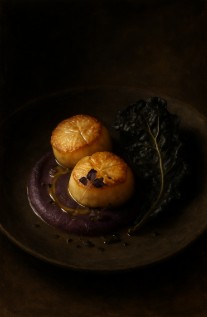“Emerging from the Shadow”
In his latest creation, Michelin-starred chef Michelangelo Mammoliti channels the dramatic intensity of Caravaggio, transforming the plate into a chiaroscuro canvas. Light and shadow, flavor and emotion, converge in a culinary masterpiece where each ingredient tells a story. This is not just gastronomy... it’s art in its most evocative form.
MASTERCHEFS & MASTERPIECES
Charlotte Madeleine CASTELLI
8/9/20252 min read


Michelangelo Mammoliti’s Caravaggesque Culinary Masterpiece
In haute cuisine, certain dishes transcend mere sustenance to become acts of poetic creation, where taste and visual artistry converge into a singular experience. Emerging from the Shadow, crafted by two-Michelin-starred Chef Michelangelo Mammoliti of La Rei Natura in Serralunga d’Alba, is one such exceptional composition, a culinary tableau vivant inspired by the dramatic chiaroscuro of Caravaggio.
Mammoliti orchestrates a compelling interplay of contrasts: the profound darkness of violet potato purée and charred black cabbage leaves confronts the luminous warmth of seared scallops. Here, light is not merely a chromatic element but a gustatory dimension, embodied in a delicate lemon and extra-virgin olive oil emulsion that pierces the plate like a beam illuminating a Caravaggesque interior.
Each component is placed with atelier-like precision. The earthy, textured vegetal base anchors the visual and aromatic gravity of shadow, while the ethereal, tender scallops articulate the gustatory brilliance of light. Drops of black truffle oil and flakes of black Maldon salt serve as painterly accents, guiding the diner's gaze—and palate—towards the dish’s narrative core.
Emerging from the Shadow is not simply an appetizer; it is a sensorial and aesthetic experience that evokes the Baroque theater, capturing a moment of suspended drama and intensity. On the plate, it invites reflection on art’s transformative power—to reveal the light hidden deep within darkness.
Much like standing before a Caravaggio masterpiece, one is drawn into silence, holding breath. Then, with the first bite, chiaroscuro dissolves into flavor.
Recipe (Serves 4)
Ingredients
Fresh scallops – 8 large, cleaned
Black cabbage leaves – 4, blanched and cooled
Violet potato purée – 200g
Lemon and extra-virgin olive oil emulsion – 50 ml
Black Maldon salt flakes
Black truffle oil – a few drops
Microgreens (purple basil or purple coriander) for garnish
Preparation
Scallops: Heat a pan until very hot. Lightly sear the scallops for about 30 seconds per side, achieving a golden crust while maintaining a tender, almost raw center.
Purée: Boil violet potatoes until tender. Mash into a smooth purée, ensuring a velvety texture and deep color. Place a neat dollop at the center of each plate.
Black cabbage: Arrange a leaf beside the purée, its matte blackness evoking shadows embracing the light.
Assembly: Position the scallops atop the purée. Drizzle with the lemon-olive oil emulsion, adding a fresh, acidic brightness that cuts through the richness.
Finishing touches: Sprinkle black Maldon salt flakes and add a few drops of black truffle oil for aromatic depth. Garnish with microgreens, adding a delicate hint of color and freshness.
Curatorial Statement
Emerging from the Shadow by Chef Michelangelo Mammoliti exemplifies the sublime dialogue between light and darkness emblematic of Caravaggio’s chiaroscuro. This dish is a meticulously crafted narrative, a staged encounter where texture, color, and flavor converse in baroque tension.
The velvety violet purée and rugged black cabbage leaves act as a visual and textural anchor—a somber stage—while the luminous scallops serve as the drama’s protagonists, illuminated by the sharp vibrancy of the citrus emulsion. The subtle umami resonance of truffle oil and the crystalline spark of black salt punctuate the composition like brushstrokes that guide the eye—and the palate.
More than an appetizer, this creation is a multisensory experience that invites diners into a moment of suspended time, mirroring the emotional intensity and theatricality of Baroque art. It is an invocation of art’s transformative potential, illuminating the hidden depths within shadow and evoking a profound sensory meditation.
© Charlotte Madeleine Castelli | All rights reserved
